Chorek (choreg) is a very traditional Armenian sweet bread that is typically made around Easter and even Christmas. It is enriched with eggs, butter, milk, and sugar to make it slightly sweet, rich, and tender-crumbed.
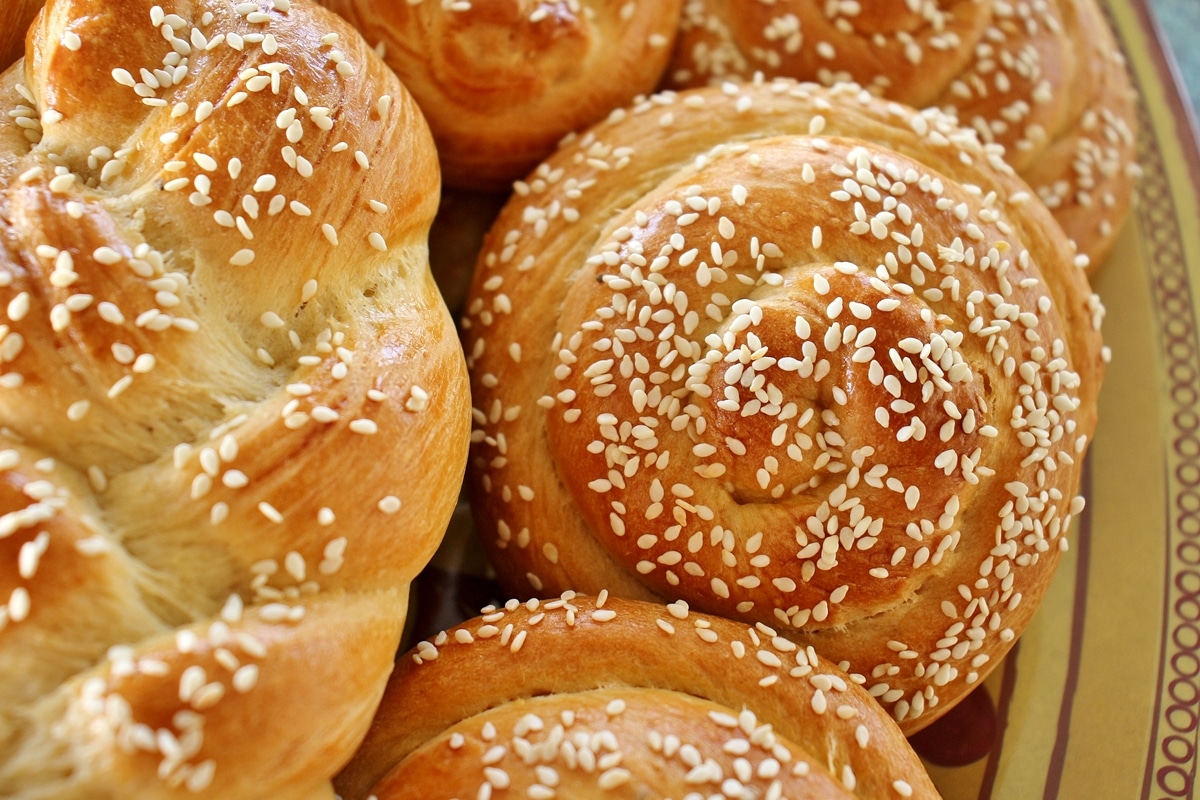
(This recipe for chorek / choreg was originally published in April 2011, but was updated with new photos and content in 2020).
Many cultures have variations of sweet bread. Sweet bread often refers to a bread that is not particularly sweet but is rather enriched with fat, eggs, and sugar. This yields a softer crumb with a hint of richness and sweetness.
Enriched breads are also more yellow-hued due to the addition of eggs. Every culture that has a version of sweet bread typically has something unique to their recipe that sets its apart, including Armenian chorek (choreg). Here are some other sweet breads from around the world!
- Brioche (French): uses a bit less sugar than some other cultural sweet breads, and can be shaped a variety of ways. Brioche à tête is formed in a fluted round pan, while Brioche Nanterre is made in a standard loaf pan.
- Challah (Jewish): often made for Shabbat and major Jewish holidays. It's traditionally braided, and usually features 3, 4, or 6 strands for increasingly complex-looking braids.
- Tsoureki (Greek Easter Bread): often has red dyed Easter eggs pressed into the braided dough. It occasionally includes other seasonings such as chopped nuts, orange zest, and/or mahleb.
- Pane di Pasqua (Italian Easter Bread): often features citrus and/or anise flavors, and is braided into a ring with dyed Easter eggs pressed into the dough.
- Massa Sovada or Pão Doce (Portuguese): usually a round dark loaf served with butter.
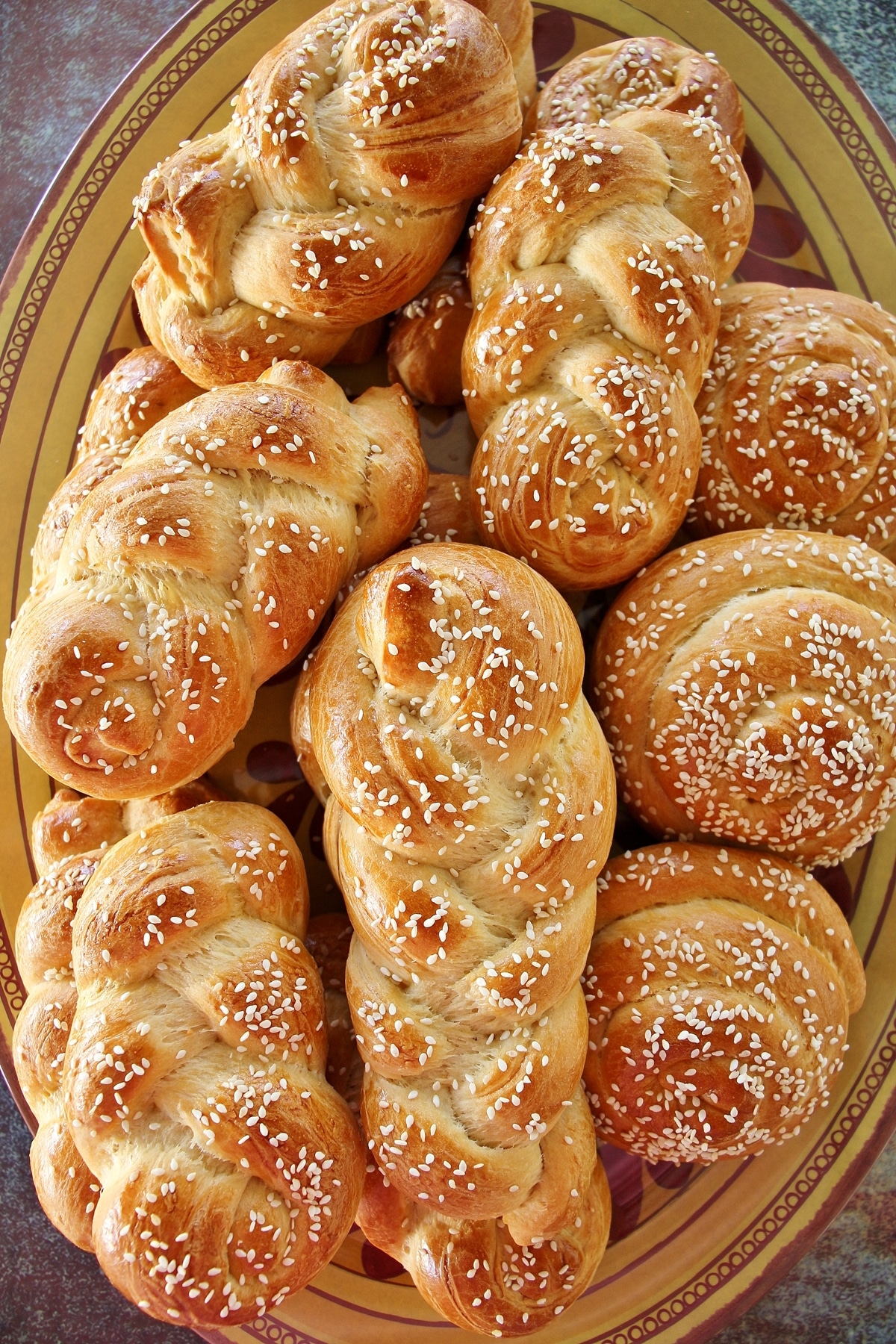
What is mahleb?
The Middle Eastern spice mahleb or mahlab is the ingredient in Armenian sweet bread that sets it apart from others. Mahleb comes from the stones of St. Lucy’s cherries. Its aroma is reminiscent of cherry, almond, flowers, and rose water.
It imparts a sweet/sour and nutty flavor with a slightly bitter aftertaste. It’s a common addition to breads, pastries, and other sweet confections of the Middle East and Eastern Mediterranean.
Mahleb is more readily available around Easter and can be purchased at Middle Eastern or Greek markets, or even online. Once ground, it looses its flavor and aroma rapidly. Store it in an air-tight container and refrigerate or freeze for longevity. You may also purchase the spice whole and grind it yourself before each use.
If mahleb is unavailable it can technically be omitted from the choreg recipe, but I don't recommend that! You'll miss the traditional sweet aroma that makes choreg unique. Make an effort to source this ingredient if you are interested in making Armenian sweet bread.
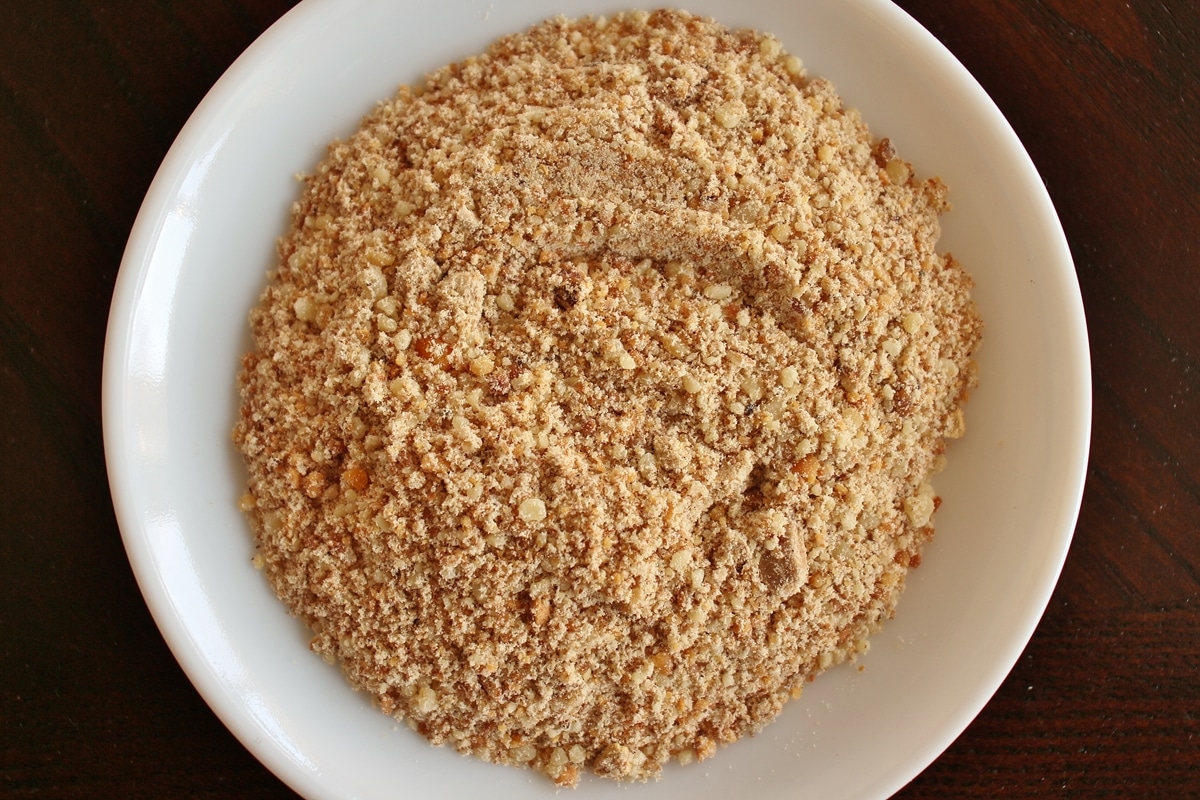
How to make it
The first step to make chorek (choreg) is to combine warm water with active dry yeast and sugar. Allow the yeast to bloom and soften. Because of the addition of sugar (yeast's favorite food!) the mixture should get frothy and release carbon dioxide. Make sure your bowl isn't too small or it may overflow.
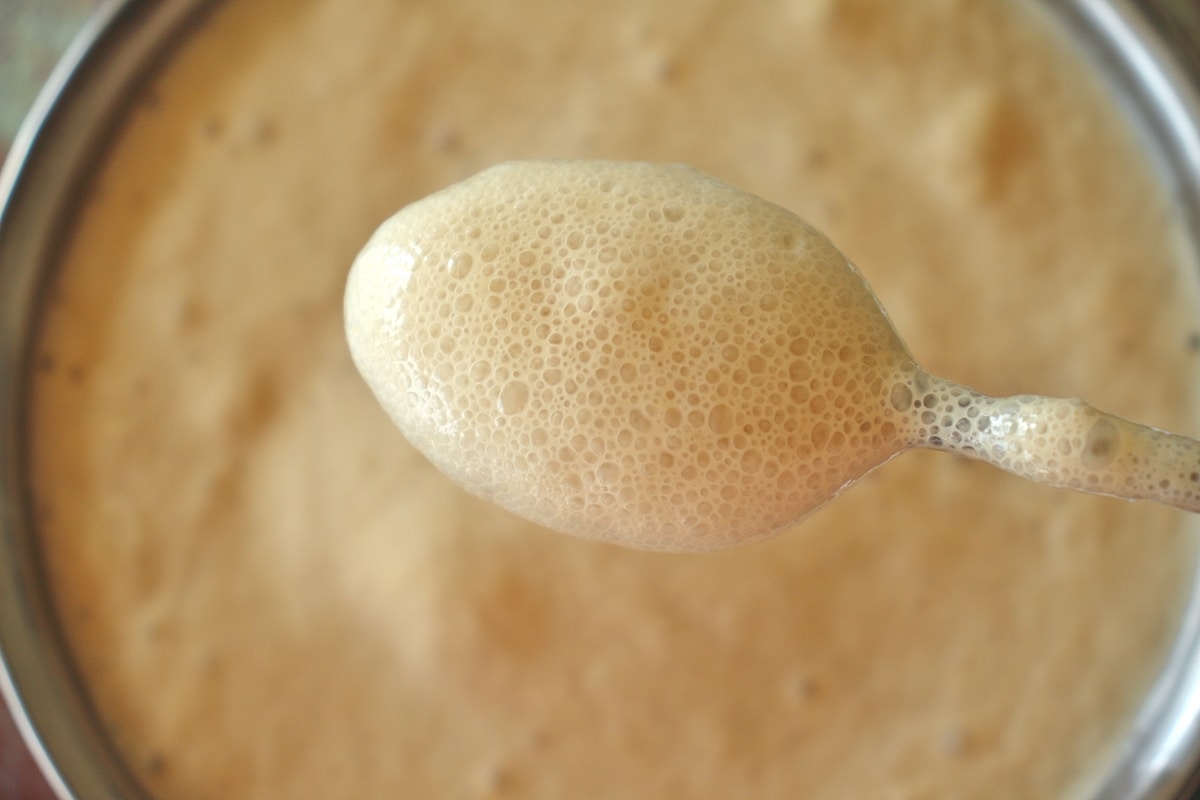
In a medium mixing bowl beat together the remaining sugar, eggs, whiskey or brandy, and vanilla extract. Slowly beat in simmering milk, being careful to gently heat the egg mixture so the eggs don't curdle. Then whisk in melted butter and finally the yeast mixture.
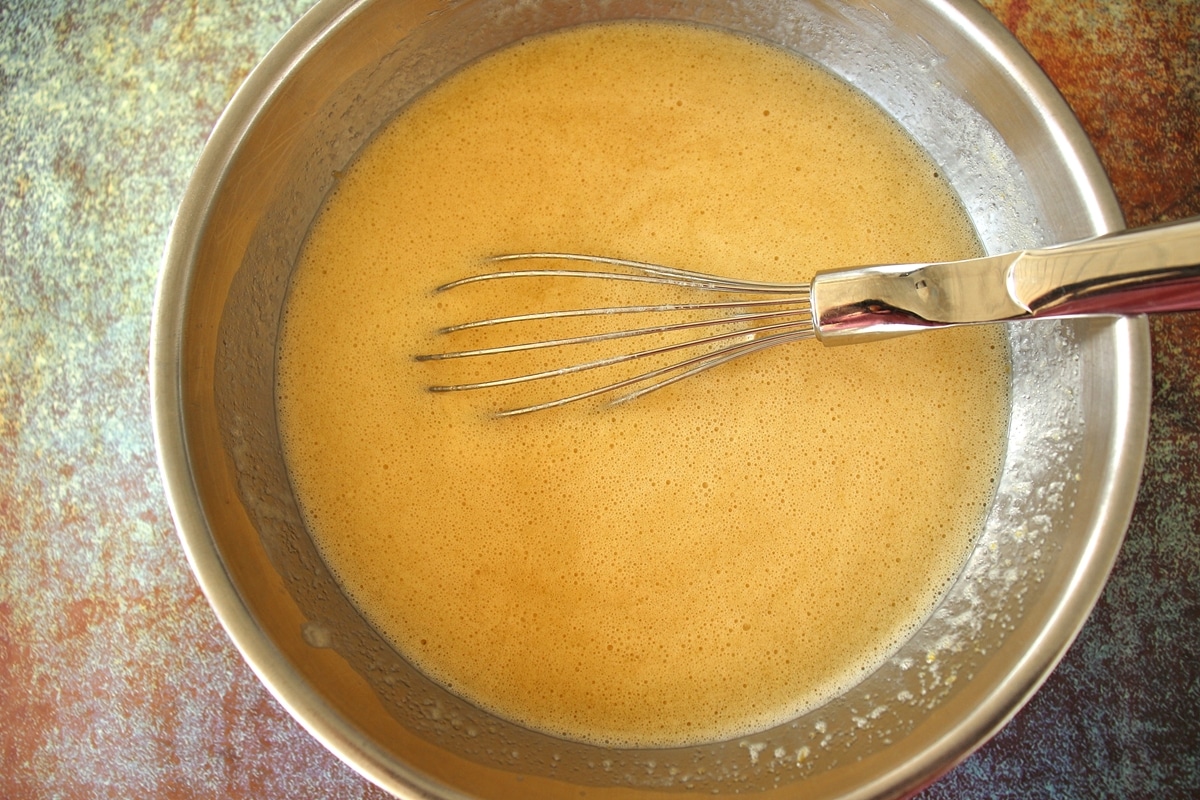
In a large mixing bowl combine the dry ingredients: flour, mahleb, baking powder, and kosher salt.
*A Note on Measuring Flour* Weight measurements are most accurate. This is what I recommend, and what I use. To measure in cups, spoon the flour into the measuring cup and level it off, don't scoop. Scooping flour packs the flour into the cup, and you will end up with a lot more flour than you expected. If measuring in cups start with closer to 9 and add more if needed. Again, weight measurements are ALWAYS most accurate and will ensure the best results, avoiding human error in measuring.
Create a well in the center of the dry mixture and add the wet ingredients. There's a lot, it may overflow out of the well but that's fine. Use a large spoon to mix from the center outward, and allow the dry mixture to absorb the wet mixture.
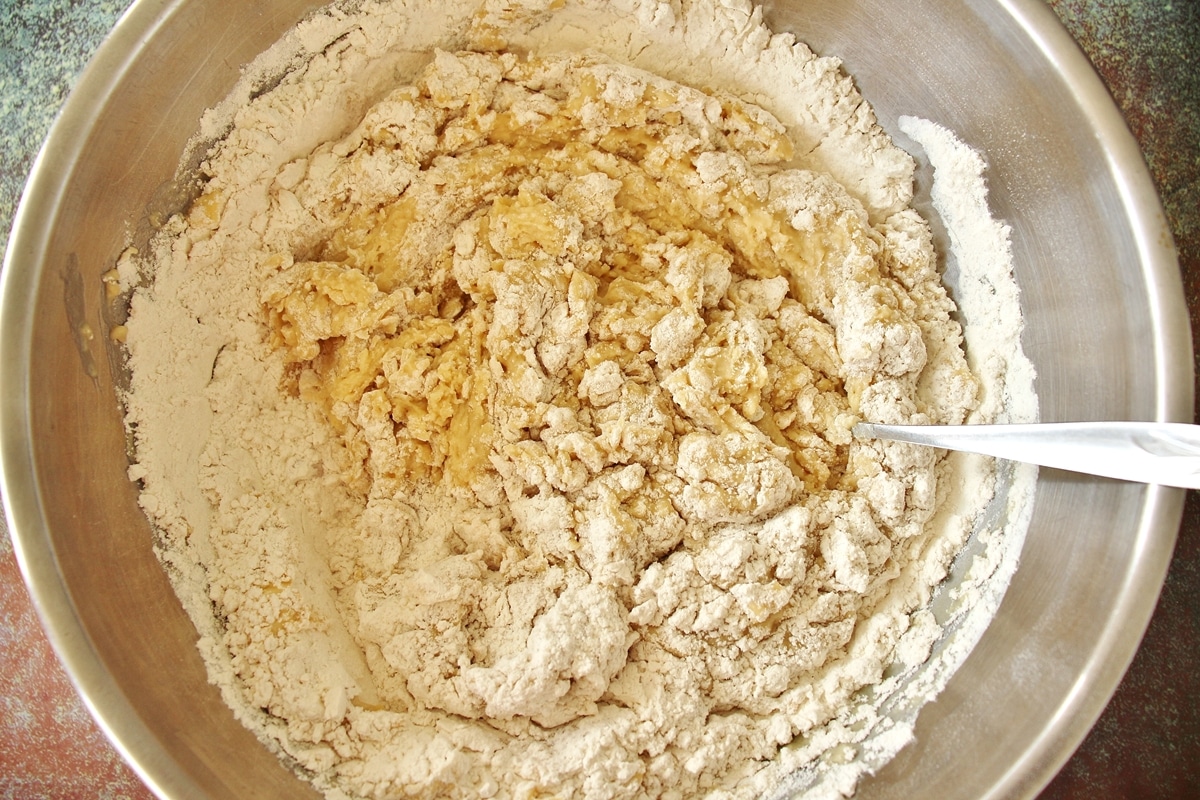
Get in there with your hands at this point, and continue mixing and kneading until all the liquid is absorbed into the dry ingredients. You should have a soft, supple, slightly tacky dough.
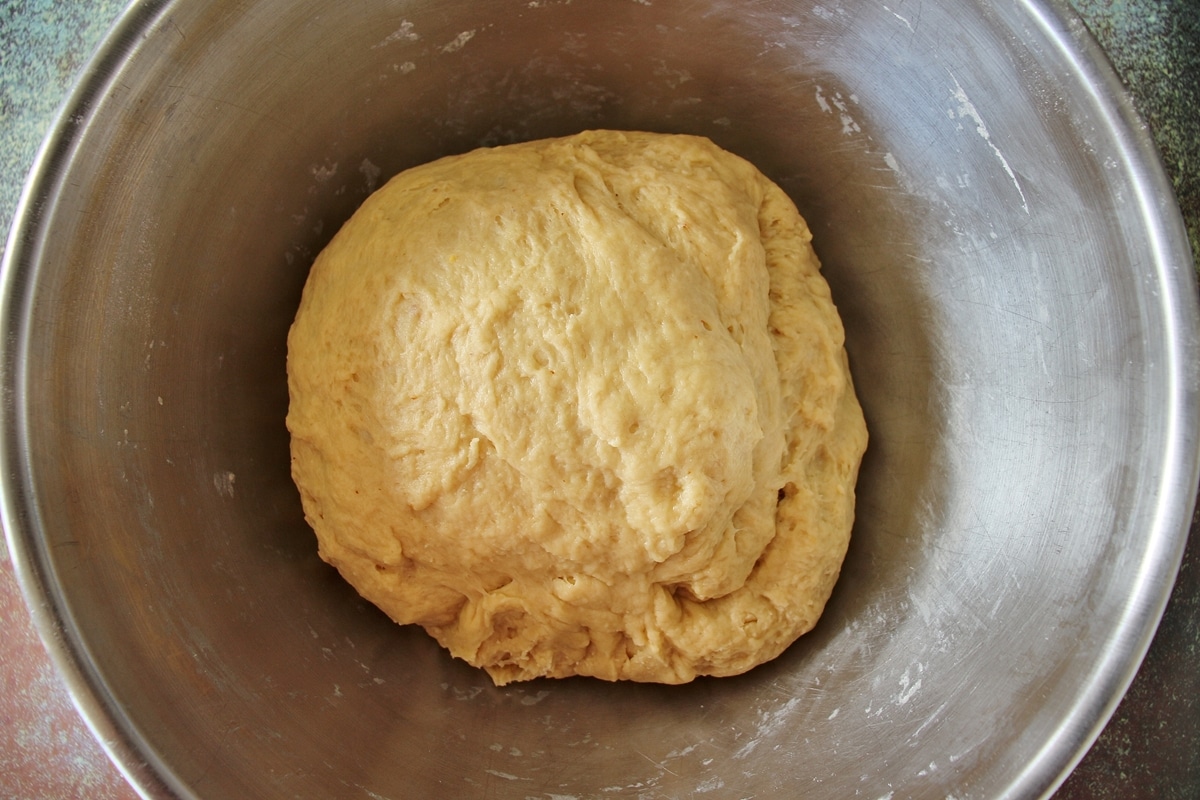
Transfer the dough to a lightly greased extra large bowl with room for the dough to double in size. If the bowl you mixed the dough in is large enough you can leave it in there, but it will expand a lot!
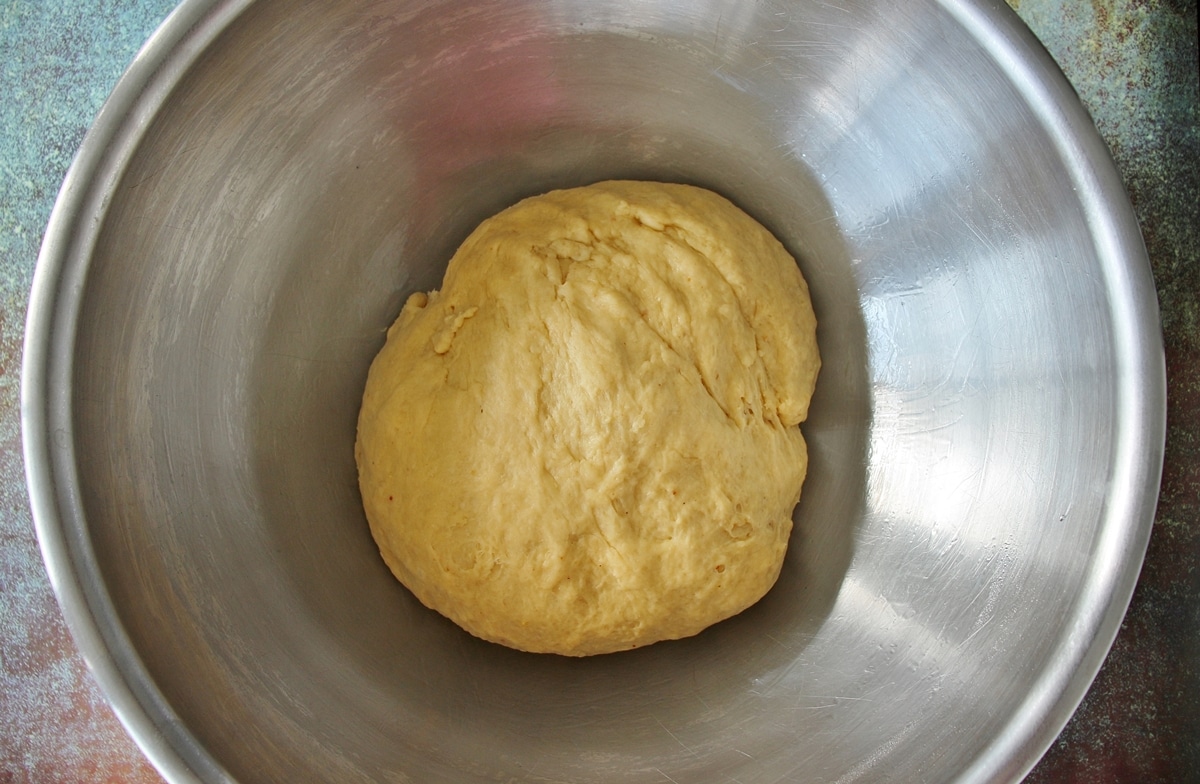
Cover the dough with a piece of plastic wrap or a clean kitchen towel and set it in a warm place to rise. I usually heat the oven for just a minute, then turn it off and put my dough in the warm but not hot oven.
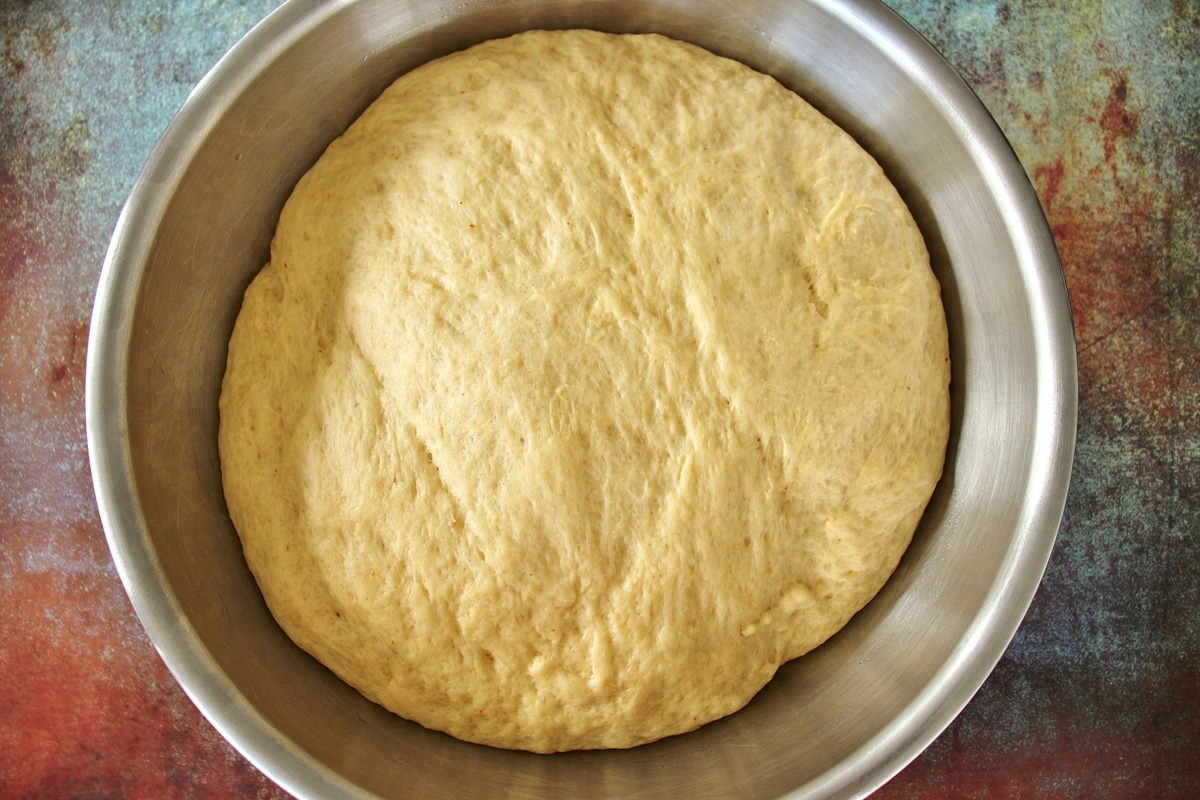
Different ways to shape chorek
Chorek (choreg) is generally prepared into smaller shapes as opposed to large loaves. Most commonly, it is braided with 3 strands which represent the Holy Trinity. These three-strand-braided breads can vary in size from smaller individual loaves, to somewhat larger ones that can be sliced and shared. It can also be shaped into snails, twists, or my personal favorite: chorek people!
I believe chorek people are an invention completely unique to my grandmother. Ever since I was little, I remember her making people shapes out of chorek for all of her grandchildren. I'm so lucky to have such a creative grandma! Chorek people look a lot like gingerbread men, but they are made of yeasted dough and therefore require a bit more effort to shape than using a cookie cutter.
It's pretty easy though, and especially fun for children (or me) to eat these adorable people-shaped sweet breads. Just remember to remove the clove eyes before eating 🙂 Someday, I would love to make a full batch of chorek people, and create a whole community called Chorek Land. Kind of like Candy Land but exponentially more awesome. Read on to learn how to make the different shapes.
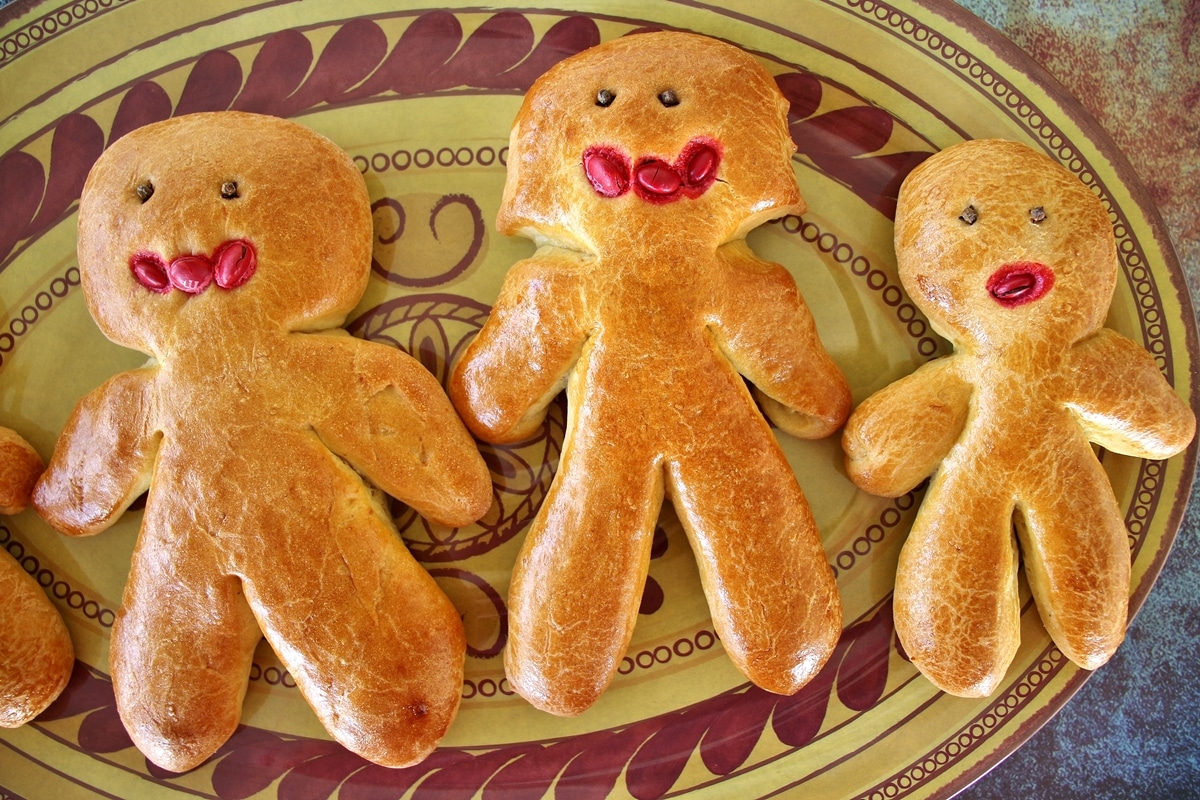
How to make a braid
Roll out a piece of dough between your hands and the work surface until you have a ½-to-¾-inch thick rope. Cut off ⅓ of the length of the dough and attach it to the center of the longer piece by pressing the pieces together.
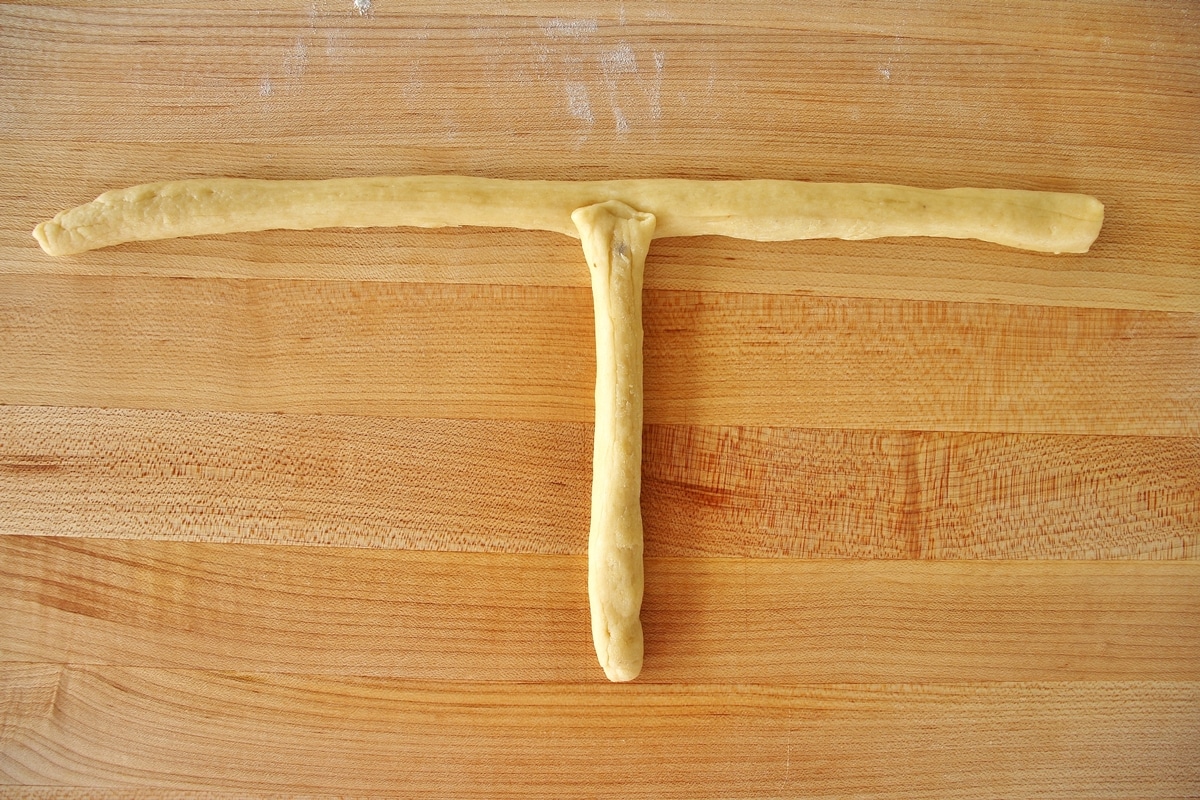
Very loosely braid the ropes together (the braid will proof and get bigger later, so don't braid tightly). Press the ends together to "seal" the braid.
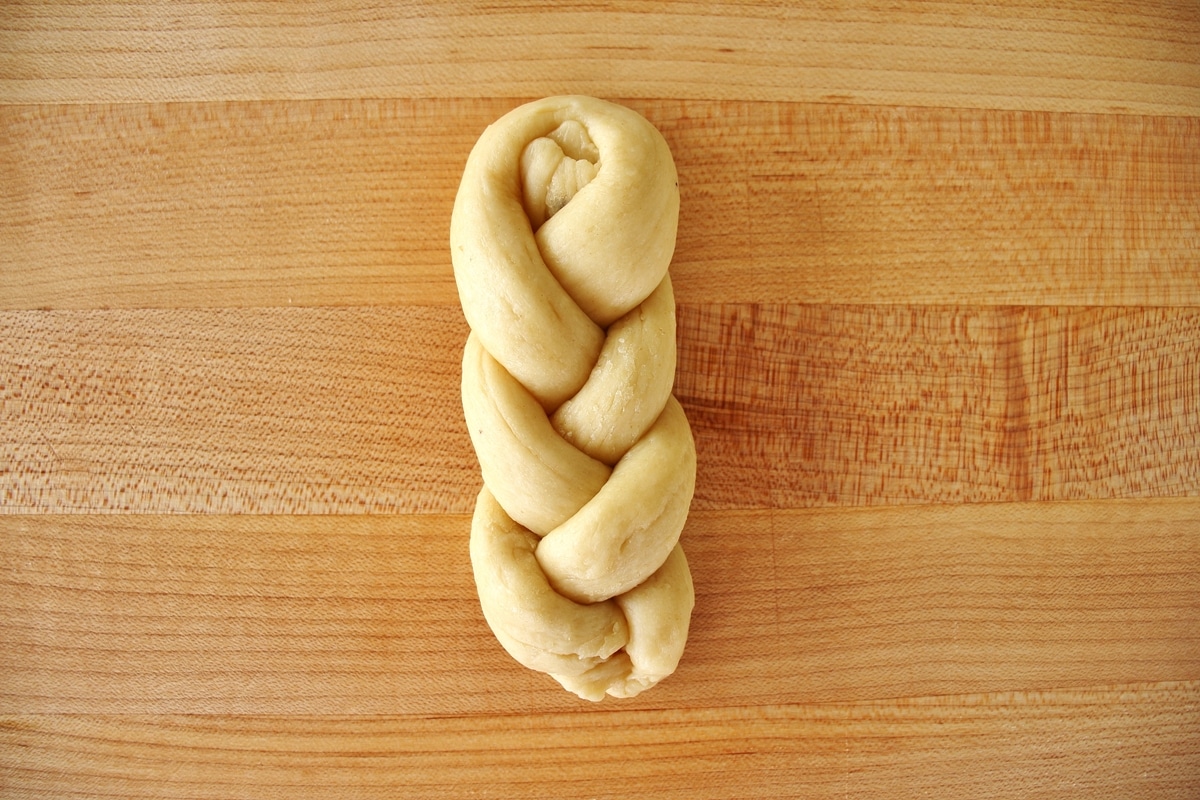
How to make a snail/spiral
Roll out a piece of dough between your hands and the work surface until you have a ½-to-¾-inch thick rope. Gently and loosely wrap the dough around itself starting from the center and moving outward. Tuck the end under the dough and gently press to seal it closed.
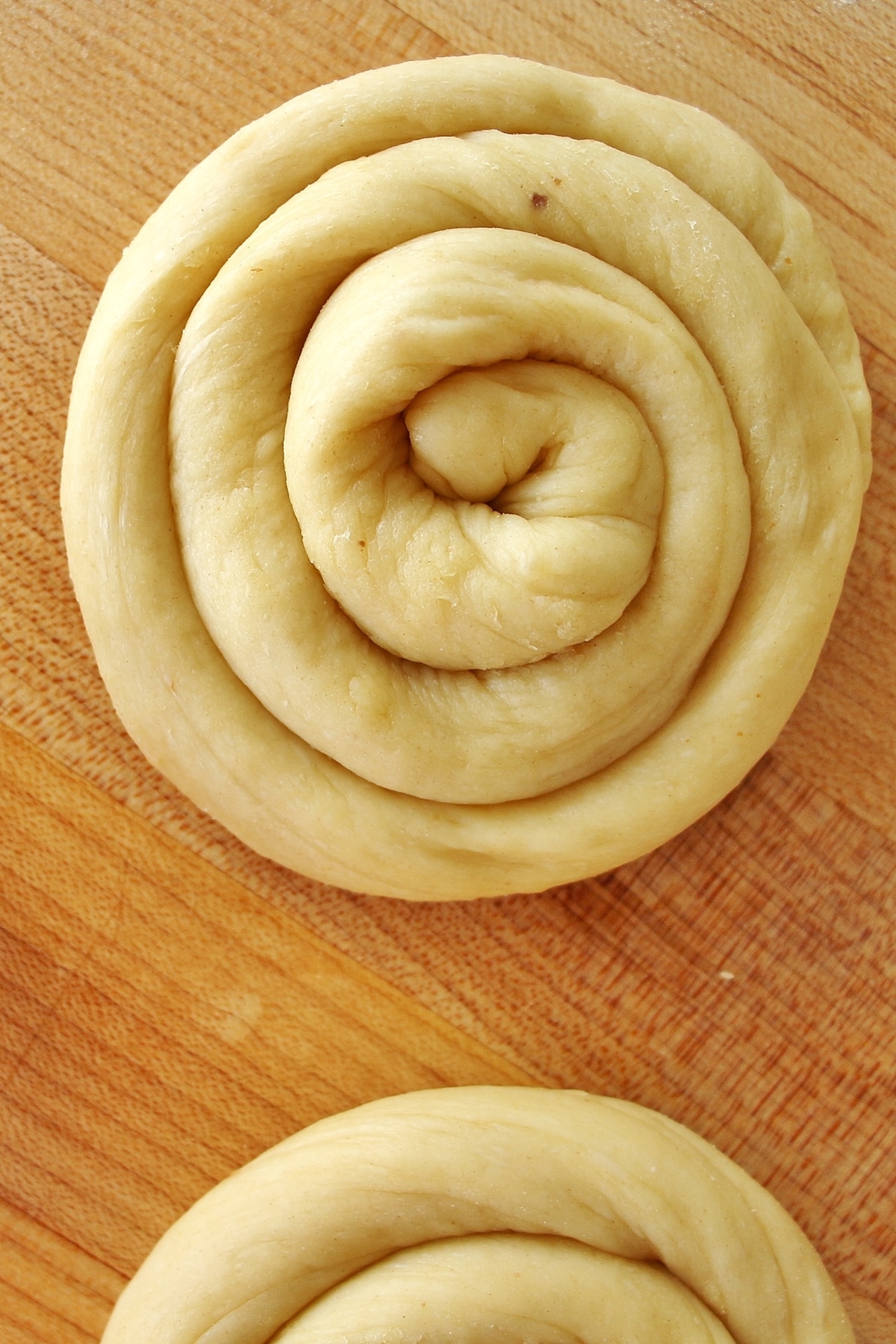
How to make a chorek person
Lightly flour your work surface and hands, and roll out a piece of dough between your hands and the work surface to create an even cylinder. Pat the dough out into a rectangle with the long sides on the left and right. Use a bench scraper or knife to cut a slit at the bottom (for the legs), 2 slits on either side (for the arms) and another 2 slits slightly above the arms (for the head).
Tuck under the pointy ends of the arms. Adjust the dough around the head to either make it look like hair (for a girl), or tuck the points under the head to make it round (for a boy). Use whole cloves for the eyes, and red M&Ms for the mouth.
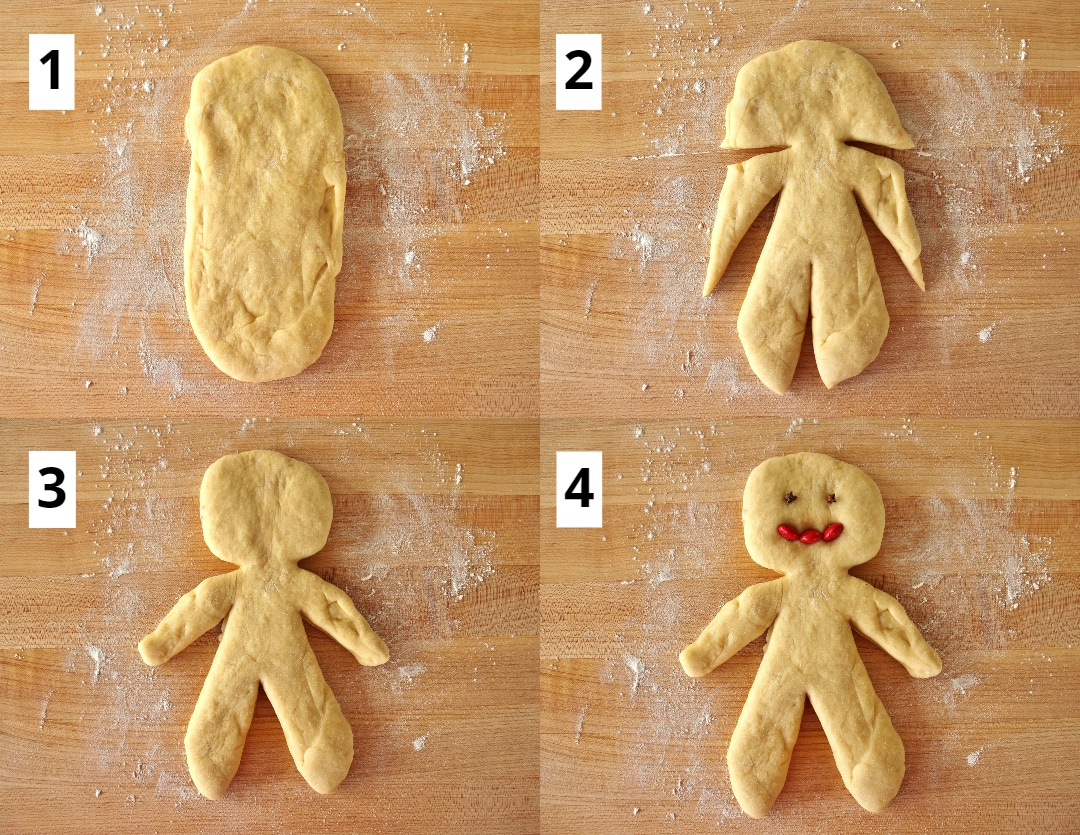
Very carefully use a large floured spatula or bench scraper to transfer chorek people from the work surface to the baking sheet. They are more fragile than the other shapes. You can make adults and children by making different-sized chorek people.
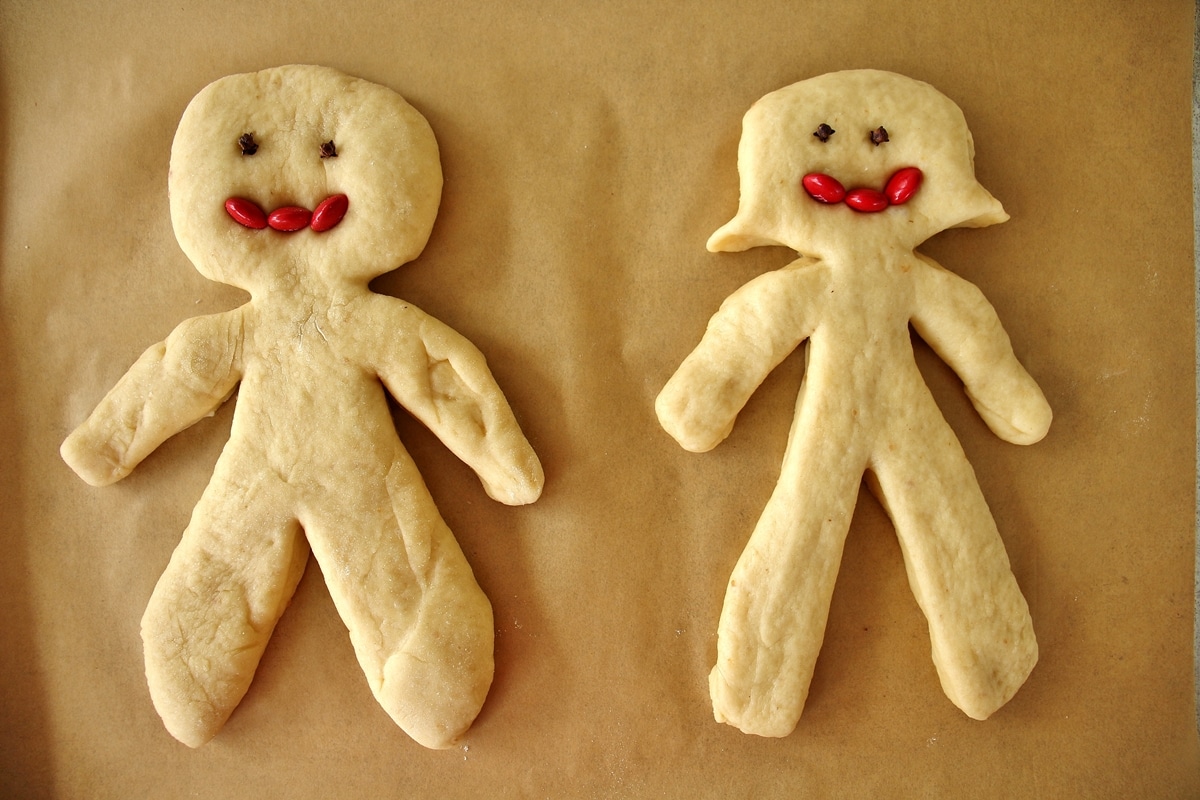
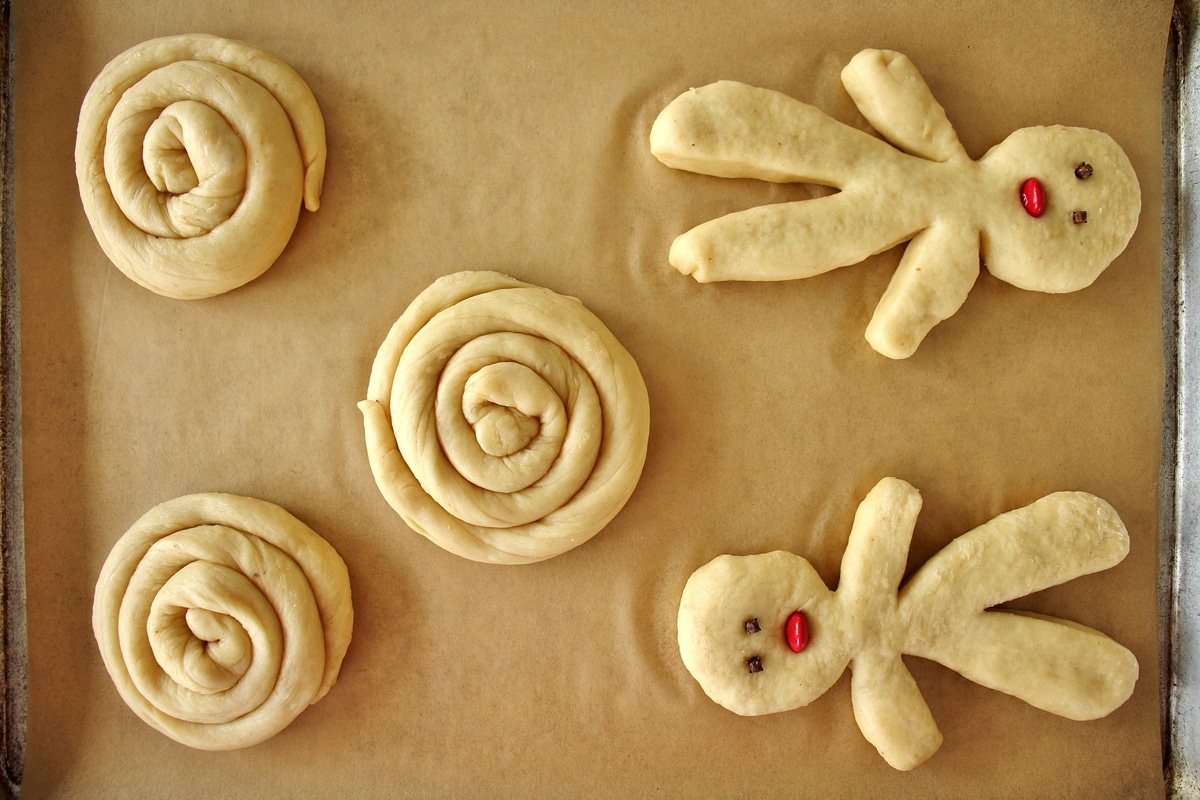
Please keep in mind that chorek people typically bake faster than some of the other shapes, so keep an eye on them so they don't dry out. Remove the clove eyes before eating.
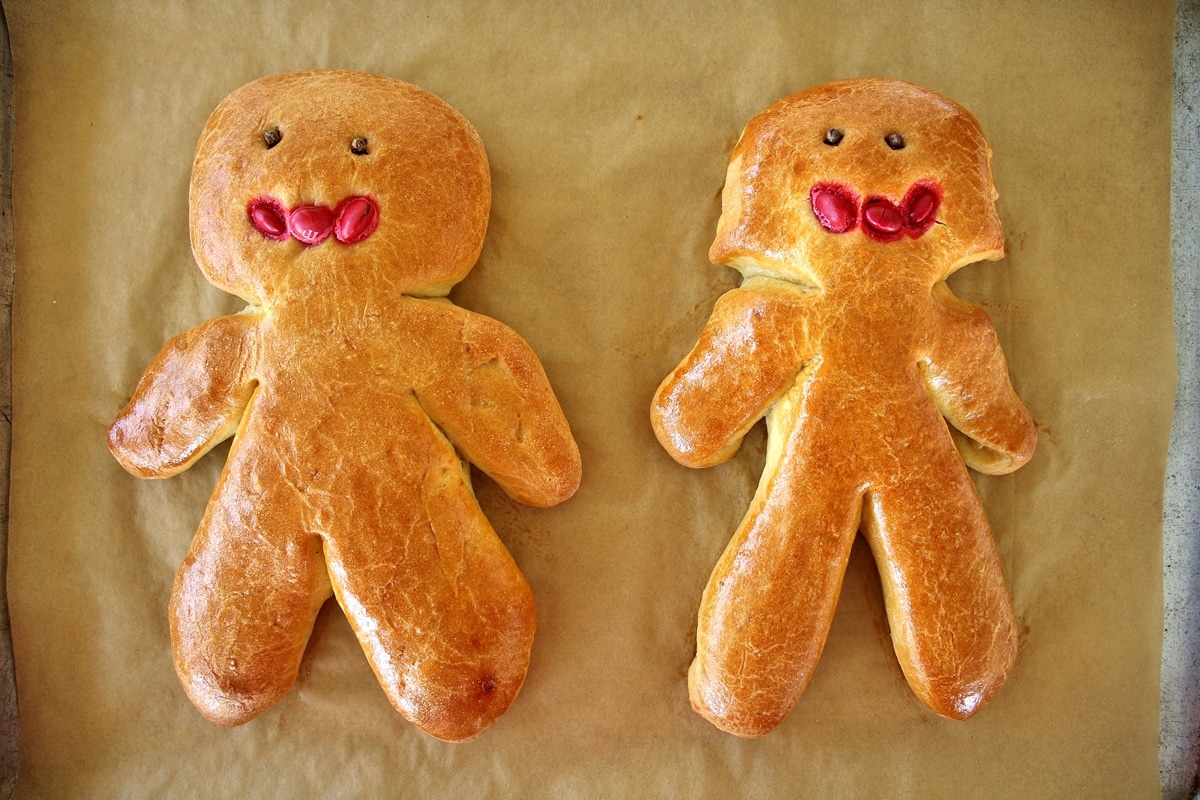
Baking chorek
Arrange the choreks on parchment-lined or lightly greased baking sheets. Depending on the shapes and sizes you make you will likely need 3 to 4 baking sheets. Don't arrange the shapes too close to each other, because they will expand. Allow the shaped breads to rise for about 15 to 30 minutes in the slightly warm oven (or another warm-ish space).
Brush the tops and sides of all the choreg breads with an egg wash mixture made with 1 whole egg, an egg yolk, and a little sugar. This is always how my grandmother did it so I'm not messing with tradition.
Top the egg-washed braids and snails with sesame seeds. The chorek people don't require sesame seeds. Bake the trays in batches 2 at a time for about 28 to 32 minutes, rotating from top to bottom and front to back halfway through.
Chorek should be stored at room temperature in an air-tight container, but can be warmed up before eating, if desired. They can also be frozen, thawed, and enjoyed at a later date. Refresh previously frozen chorek for a few minutes in the oven before serving.
Please scroll to the bottom of the post for the full recipe (in a printable recipe card) including ingredient amounts and detailed instructions.
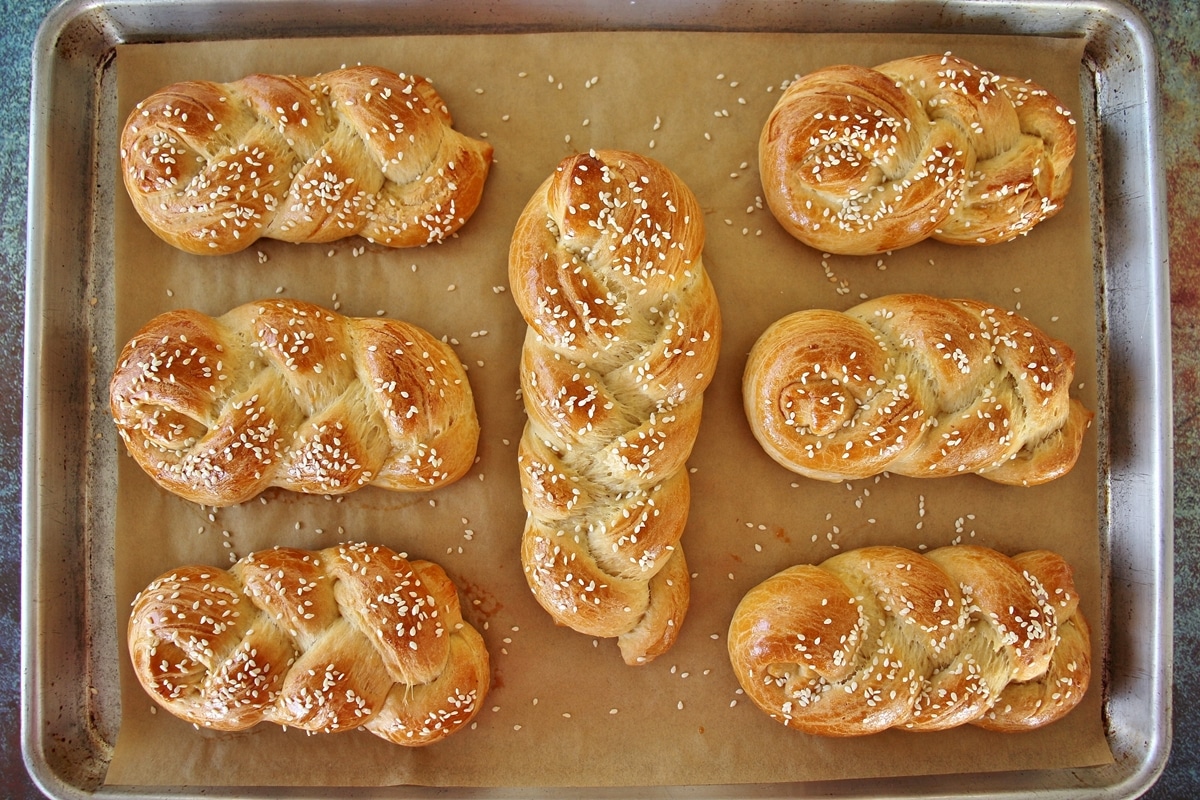
Other recipes you may like
- Brioche
- Zopf / Butterzopf (Swiss Braided Bread)
- Viennoise au Chocolat (Vienna Bread with Chocolate)
- Za'atar Manakish Bread
- Armenian Gata
- Armenian Khalkha (Simit/Kekhke)
- Paklava (Armenian Baklava)
- Sari Burma (Burma Baklava/Rolled Baklava)
- Kadaif or Kadayif (Ricotta Cheese Kunafa)
- Atayef bil Ashta (Cream Filled Pancakes)
Have you ever tried chorek (choreg) or other culturally diverse sweet breads from around the world? I'm always fascinated to learn how different people celebrate holidays through food.
For Armenians chorek is pretty non-negotiable at Easter. Nearly every Armenian family will feature chorek on the Easter menu, and sometimes on their Christmas menu too!
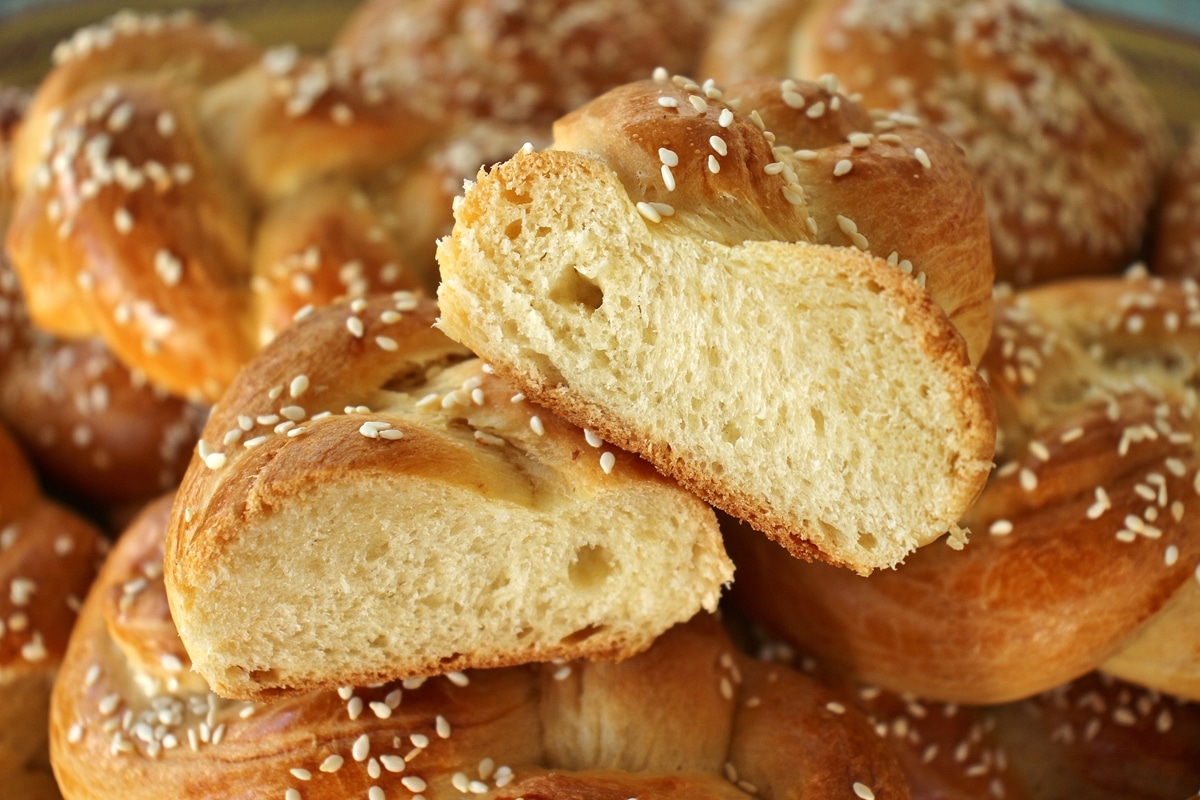
Tried this recipe? Please leave a star ⭐️⭐️⭐️⭐️⭐️ rating in the recipe card below and/or a review in the comments section further down the page. You can also follow me on social media on Facebook, Instagram, and Pinterest!
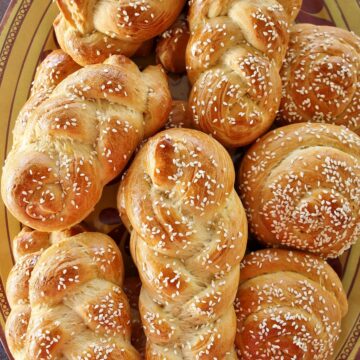
Chorek / Choreg (Armenian Sweet Bread)
Ingredients
Yeast Mixture:
- 4 ½ teaspoons (14 grams / ½ ounce or 2 packets) active dry yeast
- ½ cup warm water (100 to 115°F)
- 1 teaspoon (4 grams) granulated sugar
Dough:
- 2 ¼ sticks (255 grams / 9 ounces) unsalted butter
- 1 cup milk
- 1 cup (200 grams / 7 ounces) granulated sugar (see notes below)
- 5 large eggs at room temperature
- 1 ½ teaspoons whiskey or brandy
- 1 teaspoon pure vanilla extract
- 42 ounces (1190 grams / about 9 to 9 ½ cups) all-purpose flour, plus more for dusting (see notes below)
- 2 teaspoons ground mahleb (mahlab) (or more if you prefer)
- 1 teaspoon baking powder
- ⅛ teaspoon kosher salt
Decorations and Eggwash:
- Whole cloves as needed (optional)
- Red M&Ms as needed (optional)
- 1 whole egg
- 1 egg yolk
- ½ teaspoon granulated sugar
- Sesame seeds as needed
Instructions
- Mix together yeast, warm water, and 1 teaspoon sugar and set aside to rise, approximately 10 to 15 minutes.
- Meanwhile, melt the butter and warm up the milk to a simmer in separate saucepans.
- In a mixing bowl, beat the eggs with the remaining 1 cup sugar, whiskey and vanilla extract. Then slowly add the hot milk, beating constantly (to gently warm the eggs), followed by the melted butter until well combined. Then beat in the yeast mixture. The liquid mixture should be fairly warm.
- In a large mixing bowl, combine the flour (weighing is more accurate than measuring in cups), mahleb, baking powder, and salt. Create a well in the center of the dry mixture and pour in the liquid mixture. Use a large spoon to gently mix the dry mixture into the liquid, starting from the center and moving outward until all the dry mixture is moistened. Start using your hands to finish mixing and knead the dough. Continue kneading until you have a soft, pliant, and slightly tacky but not-too-sticky dough.
- Place the dough in a large greased bowl (make sure that the bowl is considerably larger than the dough, as it will rise), and wrap tightly with plastic wrap or cover loosely with a clean kitchen towel.
- Briefly heat the oven and then turn it off so it's slightly warmer than room temperature but not hot. Place the dough in the warmed oven and allow it to double in size, approximately 1 ½ to 2 hours. Check on the dough occasionally to see its progress.
- On a large clean work surface, shape the dough into desired shapes as follows.
- To make the braid shape: Roll out a piece of dough between your hands and the work surface until you have a ½-to-¾-inch thick rope. Cut off ⅓ of the length of the dough and attach it to the center of the longer piece by pressing the pieces together. Very loosely braid the ropes together (the braid will proof and get bigger later, so don’t braid tightly). Press the ends together to “seal” the braid.
- To make the snail/spiral shape: Roll out a piece of dough between your hands and the work surface until you have a ½-to- ¾-inch thick rope. Gently and loosely wrap the dough around itself starting from the center and moving outward. Tuck the end under the dough and gently press to seal it closed.
- To make a chorek person: Lightly flour your work surface and hands, and roll out a piece of dough between your hands and the work surface to create an even cylinder. Pat the dough out into a rectangle with the long sides on either side. Use a bench scraper or knife to cut a slit at the bottom (for the legs), 2 slits on either side (for the arms) and another 2 slits slightly above the arms (for the head). Tuck under the pointy ends of the arms. Adjust the dough around the head to either make it look like hair (for a girl), or tuck the points under the head to make it round (for a boy). Use whole cloves for the eyes, and red M&Ms for the mouth. Very carefully use a large floured spatula to transfer chorek people from the work surface to the baking sheet. They are more fragile than the other shapes. Remove the clove eyes before eating.
- Place assembled choreks onto parchment paper-lined or greased baking sheets (leaving adequate space between the choreks as they will rise and expand further during baking). You will need about 3 to 4 half sheet pans for this amount of dough depending on the shapes you choose to make.
- Place baking sheets back into a warmed oven (make sure the oven is turned off) to allow the choreks to proof, approximately 15 to 30 minutes. Remove from the oven.
- Preheat the oven to 350°F. Beat the egg, egg yolk and sugar together and brush all the choreks (including the sides) with the egg wash mixture. Be careful with the red M&Ms on the chorek people's mouths so you don't brush red coloring onto the dough; just brush around the mouths instead of over them. Sprinkle with sesame seeds (but omit sesame seeds for chorek people shapes).
- Bake choreks for 28 to 32 minutes until golden brown (baking time will be dependent on the size of your choreks and the shapes you've made), rotating the baking sheets from top to bottom and front to back halfway through to ensure even baking. The chorek people typically bake faster than other shapes.
- Allow choreks to cool completely before serving. Choreks should be stored at room temperature, but can be warmed up before eating, if desired. They can also be frozen, thawed, and enjoyed at a later date. Refresh previously frozen chorek for a few minutes in the oven before serving.
Notes
- This is my grandmother's authentic and traditional Armenian chorek recipe, and it is written exactly the way she used to make. The resulting chorek is not overly sweet (I would describe it as mildly sweet, perfect served with Armenian string cheese!). Just like any ethnic recipe, there are many who have different traditions in how they make something. If you prefer it sweeter, you can add more sugar. Try about 100 grams (½ cup) extra, or more if you prefer it really sweet. But again not everyone makes their chorek that sweet. You can also increase the amount of mahleb if you desire (again this is personal preference).
- A Note on Measuring Flour: Weight measurements are most accurate. This is what I recommend, and what I use. To measure in cups, spoon the flour into the measuring cup and level it off, don't scoop. Scooping flour packs the flour into the cup, and you will end up with a lot more flour than you expected. If measuring in cups start with closer to 9 and add more if needed. Again, weight measurements are ALWAYS most accurate and will ensure the best results, avoiding human error in measuring. Additional information on flour measurements and conversions can be found on the King Arthur website.
Nutrition
*All nutritional information is based on third-party calculations and should be considered estimates. Actual nutritional content will vary with brands used, measuring methods, portion sizes and more.*

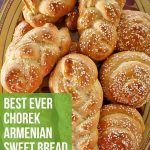
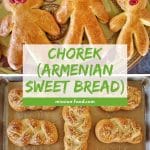

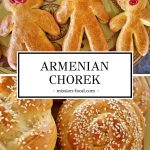
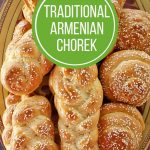



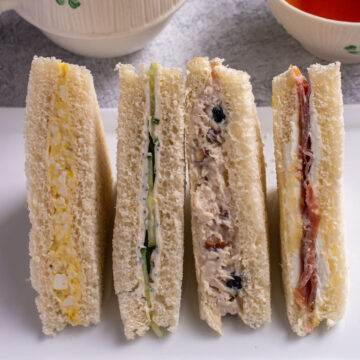
Tegra says
My husband loved this recipe! It reminded him of his grandmother’s.
Martha says
I'm in Hawaii and our daily temperatures are in the low 80s. Do I need to proof in the oven? I find other bread recipes rise in less time sitting under a towel on the counter.
thank you!
Victoria says
Hi Martha,
That's a great question! No, if it's warm in your kitchen you can let your dough rise at room temperature. Putting it in a slightly warm oven is helpful otherwise but the Hawaii weather will be perfect for proofing the chorek dough without the help of an oven. Enjoy!
Sevan says
Solid recipe. Choreg is a matter of preference and personal taste. Of course, mom made it best! Will add more salt as is called for in typical brioche recipes and also more mahleb, probably double the amount as I am accustomed to a stronger mahleb flavor. Otherwise, produced a product with great color and consistency. Recipe and instructions contain excellent detail and are simple to follow.
Jennifer says
WOW! Followed the recipe exactly and these are amazing, just like we used buy at local Armenian Grocery before they closed. I have an Armenian cookbook but the recipes are sometimes hard to follow due to some verbiage and lacking full details. I'll be trying the Yalanchi's next! So happy to have stumbled on your site! Thank you Victoria!
Victoria says
Thanks, Jennifer! I'm so pleased that you enjoyed these choreks! I hope you enjoy the yalanchi as well 🙂
Michelle says
Hi Victoria,
I lost my mothers recipe for Choreks. I came across your recipe my mother would add caraway seeds or poppyseeds. I haven’t seen any made this way on Pinterest.
It is okay to add one of these to the recipe but I don’t know how much.
My mom got this from another friend she has since passed and no one in her family had the recipe. Please get back to me.
Thank you,
Victoria says
Hi Michelle,
I've never added caraway or poppy seeds to chorek, but I'm sure you can add them. I also wouldn't know how much to add since I've never made it this way, but you could add some a little at a time and knead it into the dough and see if it looks like approximately how much your mother's chorek had in it. Maybe measure how much you add each time too so you can track and write it down for next time. Good luck!
Michelle says
Victoria thanks for getting back to me. I’ll try it. I’ll send you a message after I make them.
Michele says
Tasted like my grandmother’s but I would add a little more sugar. Took me back to my childhood!
Aida says
Hi Victoria,
Your recipe is exactly like my Mother’s. As you mentioned, the aroma of this traditional sweet bread just baked out of the oven brings back so many memories. In my family, the first warm batch coming out of the oven is pulled apart, almost inhaled, with such joy and laughter. I would like to thank you for your detailed recipe and photographs.
Sirov from Toronto
Victoria says
Hi Aida,
Thank you so much for your kind words. This is why I do what I do, so I can share these beloved recipes that help contribute to treasured family moments. You're very welcome!
Taline Fischer says
My mother made this every year. She’s been gone 15 years. You brought her back to me today. These came out wonderfully!!
Rima says
Made these yesterday they smell & taste delicious!
Glo says
Made them as a surprise for my elderly Armenian neighbors.
Came out beautiful!
Victoria says
Hi Glo,
What a fun treat for your neighbors! They are lucky to have you make it for them! I'm so glad you all enjoyed these choreks 🙂
Olivia Kasparian says
Oh the memories! My aunt used to make these for Easter. She would take it very seriously and sleep with the dough to make sure it would rise properly and we would spend hours together shaping it into different shapes and characters.
I would love to take the tradition to the next generation. To accommodate everyone, do you think I could substitute the eggs with anything? Many vegan egg-free recipes call for flax seeds or applesauce instead of eggs depending on their role. Do you think it could work?
Victoria says
Hi Olivia,
I totally agree about the memories around chorek making (and eating). Earlier this year I made a batch of this chorek and brought some to my grandmother's house and the first thing she did was deeply inhale the aroma and say "this smells just like mine!" What a great feeling 🙂
I've never made chorek with egg substitutes so I can't personally attest to how it would turn out, however I did a bit of research and it seems that you could use egg substitutes in yeast breads, but I imagine not all egg substitutes would work equally well or at all. Here is a post from King Arthur which discusses it in more detail. It's definitely worth a try! Maybe try making a small batch first to test it out 😉 Let me know if it works for you!
Olivia Kasparian says
Hello Victoria!
Thank you so much for the answer and research. I will look it up and definitely try this recipe.
I'm so glad I found your blog! So many delicious memories that I now have to recreate!
Victoria says
I'm glad you found it too! Definitely let me know how the chorek turns out with the egg replacement 🙂 I also highly recommend weighing the flour if you can, as it's always more accurate than measuring in cups.
Lucy Reinbold says
One of my favorites sweet breads of all time! Tastes exactly the way my grandma used to make it, I look forward to this every Easter!
Ann Galadzhyan says
Hello my dough didn’t rise. I want to make more and let it rest all night but it didn’t rise. Please help
Victoria says
Hi Ann. There are a few reasons why your dough may not have risen.
1) Your yeast may not be fresh. Please check the expiration date. I have made this mistake myself with yeast that had been in my fridge for a long time. I realized later it had expired. Oops! Definitely make sure the yeast is fresh!
2) You may have used water that is too hot to bloom your yeast, and if you did it would kill your yeast. I have also made this same mistake in the past with other yeast dough. It should be very warm but not super hot water. The warm water will help activate your yeast, but the hot water will kill it.
3) If room temperature in your house is chilly it will take a lot longer for the dough to rise. This is why I usually slightly warm my oven and proof my dough in there. Once again, it's important that it is warm but not too hot.
You can definitely try to slowly proof the dough overnight, but if you have old yeast or accidentally killed the yeast with too hot water, unfortunately I'm not sure there is a way to salvage it. Let me know how it goes! Good luck 🙂
Mary Kabakian says
What a great way to celebrate Easter! This brings back so many happy memories.